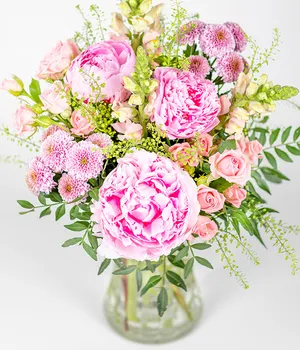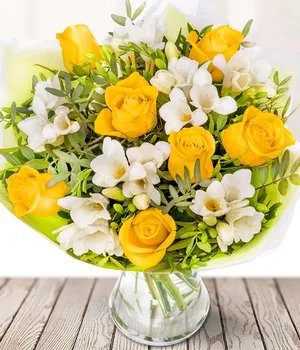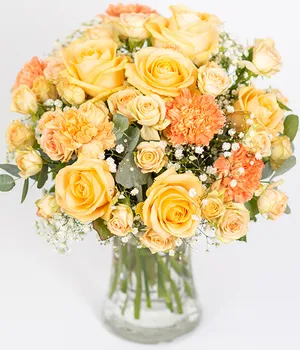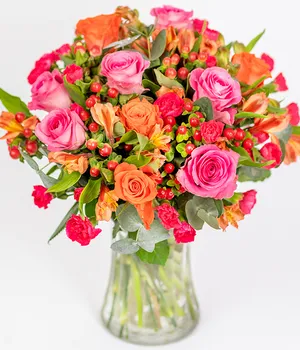Understanding pet safety with household flowers
Just like us, our pets often love flowers and it’s common for them to be drawn to them when they’re displayed around their home. However, some flowers are toxic and can cause harm to our companions. Some common symptoms of plant toxicity in pets include:
● Vomiting and diarrhoea
● Lethargy and weakness
● Excessive drooling
● Loss of appetite
● Difficulty breathing
● Irregular heartbeat
● Seizures or tremors
● Pawing at the mouth or face
Early detection is key to keeping your pets safe and healthy so make sure to contact your vet immediately if they display any of these symptoms. And of course, you can prevent your fur babies from coming to harm by choosing non-toxic flowers and plants.
View our range of pet-friendly bouquets here!
Safe flowers for pets
So, what flowers are safe for pets? The following flowers are considered non-toxic for both cats and dogs:
● Roses: A timeless classic
● Gerberas: Funky, vibrant and absolutely unmissable.
● Freesia: Delightfully scented and fantastically delicate.
● Sunflowers: Bright and cheerful.
● Snapdragons: Colourful annual flowers.
● Pansies: Beautiful and available in a range of colours.
● Limonium (aka sea lavender): A great option for adding texture to a bouquet
● Lisianthus: Elegant and long-lasting, resembling roses in their beauty.
● Pittosporum: Neat evergreen shrubs.
● Stocks: Brightly coloured with a delicious scent.
Flowers poisonous to cats
According to Cats Protection, these flowers are toxic to cats so should be avoided:
● Azalea
● Chrysanthemums (contains pyrethrin found in dog flea treatment)
● Delphinium (larkspur)
● Foxglove (digitalis)
● Fritillary (snakeshead)
● Lilies (all types - we have lily-free bouquets for this reason)
● Nerium oleander (dogbane family)
● Ornithogalum umbellatum (star of Bethlehem)
● Rhododendron
The following flowers aren’t technically toxic to cats but can still be harmful:
● Alstroemeria
● Amaryllis
● Carnations
● Clematis
● Cyclamen
● Daffodils
● Hyacinth
● Lavender
● Peonies
● Ranunculus
● Sweet William
● Tulips
This is a selection of the most common flowers, but you can see more in the Cats Protection pamphlet on dangerous plants and flowers.If your cat ingests a toxic flower, remove any plant material from its mouth, keep it calm and minimise stress and movement, and provide plant details to your vet and follow their advice.
Flowers poisonous to dogs
According to Dogs Trust, these common flowers are poisonous to dogs and some can even be fatal:
● Amaryllis
● Alstroemeria (Peruvian lily)
● Azalea
● Baby's breath (Gypsophila)
● Crocus
● Cyclamen
● Delphinium
● Foxglove
● Geranium
● Hellebores
● Hibiscus
● Lilies (we have lily-free bouquets for this reason)
● Mistletoe (berries)
● Poinsettia
● Rhododendron
● Sweet pea
See the full factsheet from Dogs Trust for more details. Keeping these flowers out of your home is the best way to keep your dog safe but if you do have any of these on display make sure they’re out of reach or use barriers. You could also train your dog and teach them to avoid these flowers using commands like "leave it."
Additional pet-friendly plant options
It’s easy to make simple swaps that replace harmful flowers with safe and equally beautiful alternatives. For example, orchids instead of lilies, Christmas cactus instead of amaryllis, and snapdragons instead of tulips.
And beyond flowers, there are plenty of pet-friendly plants too. Popular types include Boston ferns, spider plants and African violets. Care for these by ensuring they get the right amount of water and light and prune regularly to encourage growth. Make sure you only use pet-friendly fertilisers and pest control treatments.
Frequently Asked Questions
All roses are perfectly safe for both cats and dogs, though it’s still wise to keep them away from pets due to the thorns.
No, freesias are both cat and dog-friendl
No, gerberas are safe for both cats and dogs.
No, sunflowers are non-toxic so won’t harm your cats and dogs.
Lavender contains a compound called linalool, which can be toxic to animals like dogs and cats, but your furry friend would need to eat a large amount of lavender to be harmed.
Yes, pansies are a beautiful pet-friendly option.
Marigolds sit in a grey area. They are not technically toxic to cats, but Cats Protection advises caution as there is still a risk they could harm your feline friend. The same is true of dogs, though Dogs Trust highlight the marsh marigold as a poisonous variety, warning that it can be harmful if eaten in quantity.
As a lily, alstroemeria (aka the Peruvian lily) is mildly toxic and could potentially cause symptoms like vomiting and skin irritation. However, it is generally considered to be safe to have around cats and dogs.
No, snapdragons are safe to have around cats and dogs.





